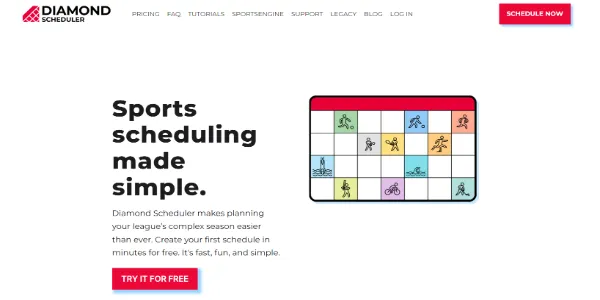
Guide to Women’s Volleyball History, Events, & Scheduling
Volleyball is a professional sport enjoyed by both men and women either indoors on a court or outdoors on the beach.
No matter where it’s played, volleyball is an excellent pastime to stay in shape, socialize with friends and teammates, and even build a career.
Read on to learn more about who invented volleyball, the history of women’s involvement in it, and how you can schedule your own tournaments with a surprisingly simple scheduling tool.
What’s the history behind women’s volleyball?
Volleyball has taken leaps and bounds into the modern era, so before we dive into new events and scheduling, let’s take a look at the sport’s humble beginnings.
William G. Morgan, serving as Physical Director at the YMCA (Young Men’s Christian Association) in Holyoke, Massachusetts, is credited as the inventor of volleyball’s precursor, ‘Mintonette,’ in 1895.
Morgan combined elements from different sports like baseball, basketball, handball, and tennis into his unique sport.
William borrowed the ball from basketball, tennis gave him the idea of the volleyball net, and using the hands came from handball’s playing method.
The competitive edge came from baseball—the notion of innings became sets.
These elements made up the basic idea of volleyball.

Volleyball was created using different aspects of sports of the time.
A year later, Morgan introduced the concept of volleyball (Mintonette) to the YMCA’s Physical Directors Conference, held at Springfield College, Massachusetts.
Morgan’s idea was to introduce a physical fitness game that was less strenuous than basketball, and women’s volleyball has increased in popularity into the sonic boom it is today.
Although the sport had no official rules (yet), it won the delegation’s favor, and volleyball spread through the YMCA’s network.
Initially, volleyball was spelled as two words—volley ball—but the official spelling became one word in 1952.
Even though there were still no official rules to the game, the game spread across the globe via the YMCA societies in countries like Africa, China, India, Europe, and South America. In Asia, the game was top-rated.
Below is a list of other interesting facts about volleyball’s history:
Volleyball was included in the Far-Eastern Games 1913, held in Manila in the Philippines.
Setting and spiking, an offensive style, was first showcased in 1916 in the Philippines.
The scoring system changed from 21 to 15 points per game in 1917, and in 1920 a step towards standardization, the rule of a maximum of 3 hits per team was introduced.
In 1947 the FIVB (Federation Internationale De Volley-Ball) was established, and the sport had an official body to regulate the sport internationally.
Two years later, the first men’s World Championship was held in Prague, and in 1952, the first women’s championship was held in Moscow.
The sport was granted Olympic status by the International Olympic Committee (IOC) in 1957.
The first volleyball Olympic game debuted at the 1964 Olympic Games hosted in Tokyo. The Japanese women’s team took first place, followed by Russia and Poland.
How has volleyball gained popularity? Growth and global reach
During the pandemic, while other sports lost athletes, volleyball continued to gain participants. Since 2002, girls’ high school volleyball participation has increased by 15%.
According to the Wall Street Journal, there has been an increase of 8.4% since 2012, and it shows no signs of stopping.
Pro leagues are also gaining traction (we’ll look at these next).
In a historic final women’s volleyball game, the U.S. team won a gold medal at the Ariake Arena in Tokyo during the 2021 Olympic Games.
This historic win is one of the top stories from the Olympic Games as the USA swept aside their longtime rival, Brazil.

U.S. women’s national team gold medal in Tokyo by USA Volleyball/Kyle Scholzen
Including women’s volleyball at the Olympic Games was a huge step forward for the sport, but there was still more work to be done.
Athletes Unlimited assigned exclusive rights to ESPN to carry coverage of their fall (October and November) season, meaning more viewers can watch the tournament and women’s volleyball playoffs.
It’s this broader network coverage that inspires the next generation of girls and women to shoot for the stars and consider a career as professional players.
What are the women’s volleyball leagues and upcoming events?
Let’s take a look at some milestones and professional leagues below.
Back in 2020, there were no pro volleyball leagues, but the playing field is starting to level in favor of women.
1. Athletes Unlimited

Athletes Unlimited volleyball
Athletes Unlimited, in association with USA Volleyball, was launched in 2021.
It offers a new way of playing women’s professional volleyball. The season lasts 5 weeks, and each week the team is changed.
A radical scoring system is used where individual team members and the whole team can gain or lose points. Season 3, featuring 44 of the world’s best women’s teams, will begin in October 2023.
2. LOVB
LOVB (League One Volleyball) was launched in October 2021 with the idea to create a ‘feeder’ system to attract female talent and retain it in the USA.
Their ‘bottom-up’ approach buys youth clubs to form their pipeline of talent feeding into the pro league.
The preseason will begin in November 2024, and games will start in January.
3. REAL Pro Volleyball

REAL Pro Volleyball website
REAL Pro Volleyball is one of the top stories for this year. Starting in February 2024, 8 teams will battle it out on the volleyball court in 16 games to earn the top spot in the final women’s volleyball tournament.
They aim to offer women players the same opportunities to become professional players without the pay gap.
Promoting women’s volleyball
Athletes Unlimited, LOVB, and REAL Pro Volleyball are filling a much-needed gap in the field by encouraging sponsorships and allowing women to excel in the sport in their home country.
LOVB, for example, has raised over $24 million since its founding in 2021 and has financial backing from big names like Kevin Durant, an NBA star, tennis star and legend Billie Jean King, and Chelsea Handler, an entertainer.
Big names like these are essential to the game’s success and retaining talent on home soil.
REAL Pro Volleyball aims to offer women the same opportunities as their male peers to earn a living wage playing professional women’s volleyball in real pro arenas.
The aim is to bridge the division between men’s and women’s volleyball, leveling the playing field and the earning and recognition gap.
Using Diamond Scheduler to schedule women’s volleyball games

Diamond Scheduler makes scheduling volleyball games simple
Whether you’re scheduling games internally or coordinating schedules with other clubs, you’ll need the tools to ensure you offer all teams the same opportunities to participate in the league.
When you consider scheduling, it can seem like a nightmare to coordinate everyone and everything.
From the initial playoffs to whittling down the top contenders to play at the season’s end, scheduling is a large time commitment—unless you have the right tools.
Every match and every point is crucial during tournament season, and there’s barely time to stop and think about anything else.
If you’ll be scheduling volleyball tournaments this season, you might want to consider the round-robin scheduling approach.
This video gives an overview of how a round-robin schedule works to benefit all groups:
Create a Round Robin TournamentBut why should you sit and try to work out schedules by hand when you can use powerful algorithms to do the hard work for you?
Diamond Scheduler is the top sports scheduling software on the market today and is ready to solve your scheduling woes!
The benefit of using Diamond Scheduler is that you can give other teams, who did not make the qualifying points during the October - November season, the opportunity to participate, too—a leaf from the NBA’s book, if you will.
Frequently asked questions
Why is schedule planning so important?
Using the round-robin schedule planning approach allows all participants an equal opportunity to score points on a ‘previous next pause’ principle (the last teams are allowed to pause and rest).
The following teams pair up and face each other, which creates a sense of excitement among the participants and viewers.
Top teams get a chance to show off their skills, and spectators can root for their favorite team.
Round-robin schedules also generate revenue for sports channels and league organizers alike.
Nevertheless, the ‘previous next pause’ principle is at work, offering spectators time to relax between games if they feel like taking a break from all the excitement.
How can you ensure fair playing schedules in women’s volleyball?
To prevent burnout, proper scheduling is important.
Teams need the time to recuperate after games, have enough time to practice, and sometimes even acclimatize to a new environment.
By using scheduling software like Diamond Scheduler, you can reserve facilities, ensure courts are available for practice sessions, and create fair game schedules and fixtures while keeping your team in top form.
Conclusion
From humble beginnings, women's volleyball has become a beloved sport worldwide.
Whether it’s college tournaments or professional sports, planning and scheduling are of the utmost importance.
Take the guesswork out of your scheduling, keep track of your team’s progress, scores, and statistics with integrated reporting features, and manage player and team information all in one place.
Diamond Scheduler is the obvious solution to eliminating scheduling horror stories, so sign up for a free trial today!
Thalia Oosthuizen has been writing in a professional capacity for over a decade. Her love for sports has led her down the path of sports writing, where her passion and skills combine. Thalia is a runner, cyclist, and swimmer, and enjoys playing tennis and hockey. Her favorite sports teams include Chelsea F.C. and the Georgian Lions Rugby Club.
About Diamond Scheduler
Diamond Scheduler makes planning your league’s complex season easier than ever. Create your first schedule in minutes for free. It's fast, fun, and simple.



